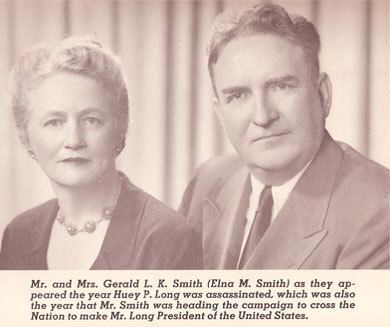Name Gerald K. Role Political leader | Party America First Party | |
 | ||
Full Name Gerald Lyman Kenneth Smith Parent(s) Sarah and Lyman Z. Smith Died April 15, 1976, California, United States | ||
Gerald l k smith
Gerald Lyman Kenneth Smith (February 27, 1898 – April 15, 1976) was an American clergyman and far-right political organizer, who became a leader of the Share Our Wealth movement during the Great Depression and later founded the Christian Nationalist Crusade. He founded the America First Party in 1944, for which he was a presidential candidate in the election that year.
Contents
- Gerald l k smith
- Gerald L K Smith 1936 Speech
- Early life and family
- Louisiana and politics
- Retirement
- References

Gerald L K Smith 1936 Speech
Early life and family

He was born in Pardeeville, Wisconsin, on February 27, 1898, to Sarah and Lyman Z. Smith. He had one sister. The family moved and the children grew up in Viroqua, Wisconsin. He graduated from Valparaiso University in Indiana in 1918 with a degree in biblical studies.
The descendant of three generations of Disciples of Christ ministers, he followed his father into the ministry, becoming ordained in 1916. He first ministered in the Midwest: Wisconsin, Illinois and Indiana.
Smith married Elna Sorenson in 1922. They adopted their only child, whom they named Gerald L. K. Smith Jr.
Louisiana and politics
Smith moved his family to Louisiana in 1928 because his wife contracted tuberculosis, and facilities in Shreveport had a good reputation for helping those with the disease. Smith served as a minister in Shreveport, making radio broadcasts attacking local utility companies and corruption, while supporting trade unions.
Smith met Senator Huey P. Long in 1929 and became his national organizer during the Great Depression, when he launched the Share Our Wealth society. This movement proposed minimum and maximum limits on household wealth and income. Smith resigned his ministry to work full-time recruiting members to the society. In describing his campaign philosophy, Smith wrote that "in order to succeed, a mass movement must be superficial for quick appeal, fundamental for permanence, dogmatic for certainty, and practical for workability."
After Long was assassinated in 1935, Smith directed the society for a short time. He became an ally of Francis Townsend, Father Charles Coughlin and Huey Long's followers to form the Union Party. It nominated William Lemke as its presidential candidate in the 1936 election.
In the fall of 1936, Smith joined the former short-term Governor James A. Noe in a tour of Louisiana in which the two railed against Governor Richard Leche's sales tax on luxury items, revenue that the governor claimed was essential for the state's share of the new Social Security program. Noe charged that Leche "sold out to Roosevelt to finance Social Security.
Unlike Long, who had been relatively tolerant on racial issues, Smith took the Share Our Wealth movement in the direction of white supremacy. As European tensions rose with the ascendancy of the Nazi Party in Germany, Smith tried to form an alliance with the non-interventionist America First Committee, but its leaders spurned him because of his anti-Semitism and racism.
In 1944, Smith formed the America First Party, essentially appropriating the name. He became a member of William Dudley Pelley's pro-Nazi Silver Shirts organization, which was patterned after Hitler's brown shirts.
Pelley was later convicted for violating the Espionage Act in 1942 and sentenced to 15 years in prison, but he was acquitted in 1944 for violating the Alien Registration Act.
Having moved to Michigan, Smith ran for the United States Senate as a Republican from there but he lost in the primary. He ran as the America First Party candidate in the 1944 Presidential election, winning 1,781 votes (1530 in Michigan, 281 in Texas). In 1948, with running mate Harry Romer on the Christian Nationalist Party ticket, he received 48 votes. Smith's only other run for the presidency was in 1956, when he received eight write-in votes in California.
After World War II, Smith continued to be active on the political right. He lobbied for decades for the release of all Nazi war criminals convicted at the Nuremberg Trials. Due to his activities, he was shunned by most politicians, including conservative figures such as Strom Thurmond of South Carolina, who distanced his States' Rights Democratic Party from Smith.
In the early 1950s, at the time of the appointment of Anna M. Rosenberg as Assistant Secretary of Defense, the Anti-Defamation League published an article that attributed the attacks on Rosenberg's loyalty to "professional anti-Semites and lunatic nationalists," including the "Jew-baiting cabal of John Rankin, Benjamin Freedman and Gerald Smith."
In 1956, Smith joined a strong campaign against the Alaska Mental Health Enabling Act. He was among such opponents as those who nicknamed it the "Siberia Bill" and denounced it as being part of a communist plot to hospitalize and brainwash Americans. It was a bipartisan, federal effort to improve mental health care for residents of Alaska, which was still a territory, and its passage was aided by the support of the conservative senator Barry Goldwater.
In 1959 the Cross and the Flag claimed that six million Jews were not killed in death camps in Europe during World War II but instead immigrated to the United States during the war.
Retirement
He eventually moved to Eureka Springs, Arkansas, where he bought and renovated a mansion as a retirement home. In 1964, he began construction of a planned religious theme park on his own property, to be called "Sacred Projects". Smith's biographer, Glen Jeansonne, in Gerald L. K. Smith: Minister of Hate, says that Smith only had $5,000 to his name at the end of 1963 and yet raised $1,000,000 by the spring of 1964 to commission and construct the "Christ of the Ozarks" project.
Although the park was never fully developed, in 1966 the centerpiece, the Christ of the Ozarks statue, was completed on Magnetic Mountain at an elevation of 1,500 feet, from where it overlooked the town. Emmet Sullivan, the sculptor, had worked under Gutzon Borglum as one of the sculptors of Mount Rushmore.
Smith's original plans were for a life-size recreation of ancient Jerusalem in the hills near Eureka Springs; no construction of this portion took place. He did initiate an annual outdoor Passion Play, inspired by another passion play which is performed every ten years in the town of Oberammergau, Germany. It is staged in an amphitheater located near the statue for several nights each week from late April through late October.
Smith died on April 15, 1976 of pneumonia. With his wife, he is buried adjacent to the Christ of the Ozarks statue, where hymns are continuously played near the graves.
